Adaptation, Innovation, and Perseverance: Thriving in the ever-evolving photography industry.
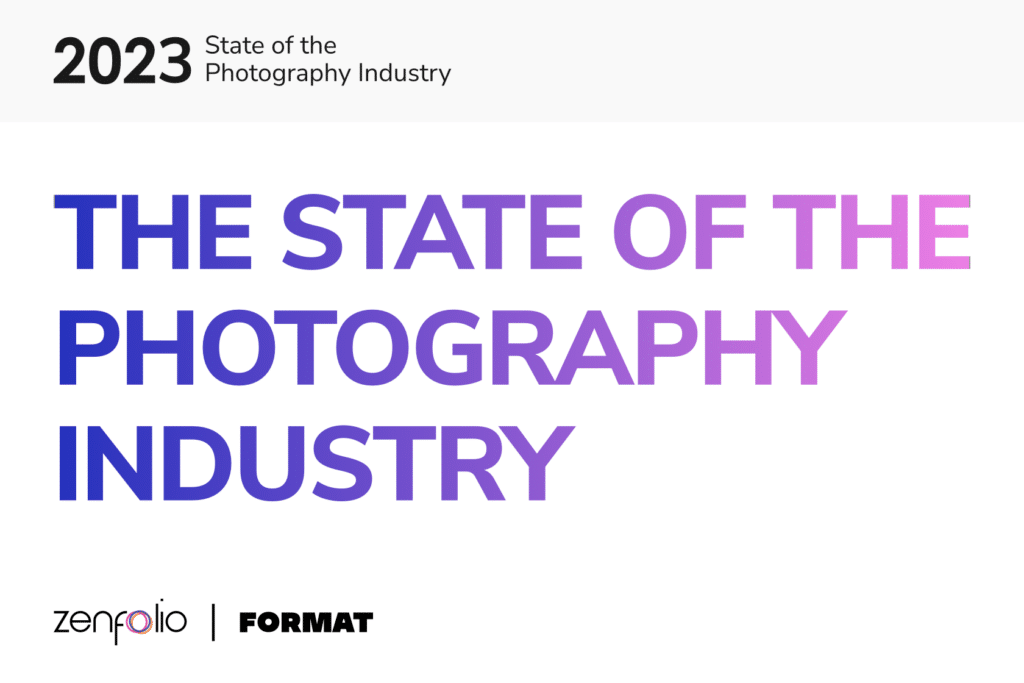
Introduction: State of photography industry report
Just like most industries and small businesses, photography over the past year has not been immune to the lingering effects of the pandemic and the challenges of a not-so-healthy economy. The most recent survey of photographers from around the world conducted in February reveals the perseverance and persistence that carried both pros and hobbyists through 2022. This fourth research survey administered by Zenfolio and Format since 2021 investigates several aspects of the industry, including areas of specialization, coping with the ongoing impact of Covid and rising inflation, how photographers package and market their services, and their sentiments about using artificial intelligence (AI) to help expedite specific tasks.
Here’s the story photographers told about last year and what they anticipate for 2023…
Where in the world?
The sample group in the February 2023 survey are mostly located in the US – 68% – followed by the UK, Canada and Australia. Besides the North America continent, Europe had the second highest concentration of respondents with the remainder scattered just about everywhere else around the globe. Even photographers in remote locations like East Timor and Djibouti participated in the survey.
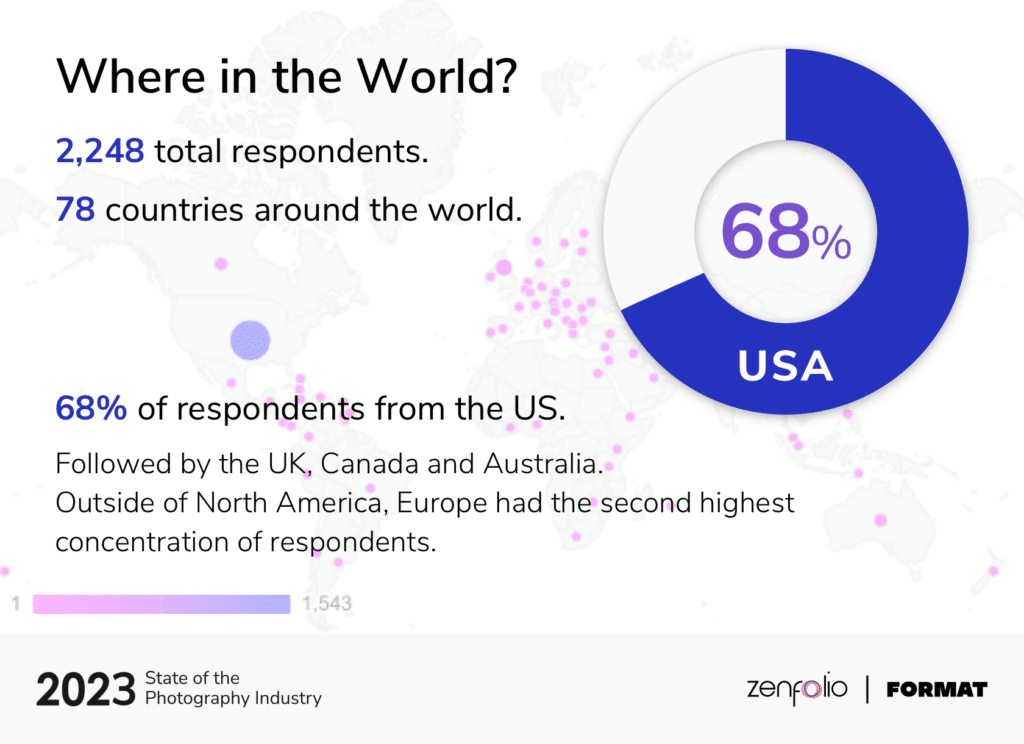
What do you call yourself?
Overwhelmingly, 88% of respondents consider themselves professionals in the photography industry. The majority are photographers/videographers with about 1% of these being educators, editors, studio managers and assistants. The remaining 12% declare themselves hobbyists and students.
Of those who earn money from photography, 94% are self-employed, with the largest group saying they are part-time, followed by another large group calling themselves full-time self-employed. Only 6% are full or part-time employees.
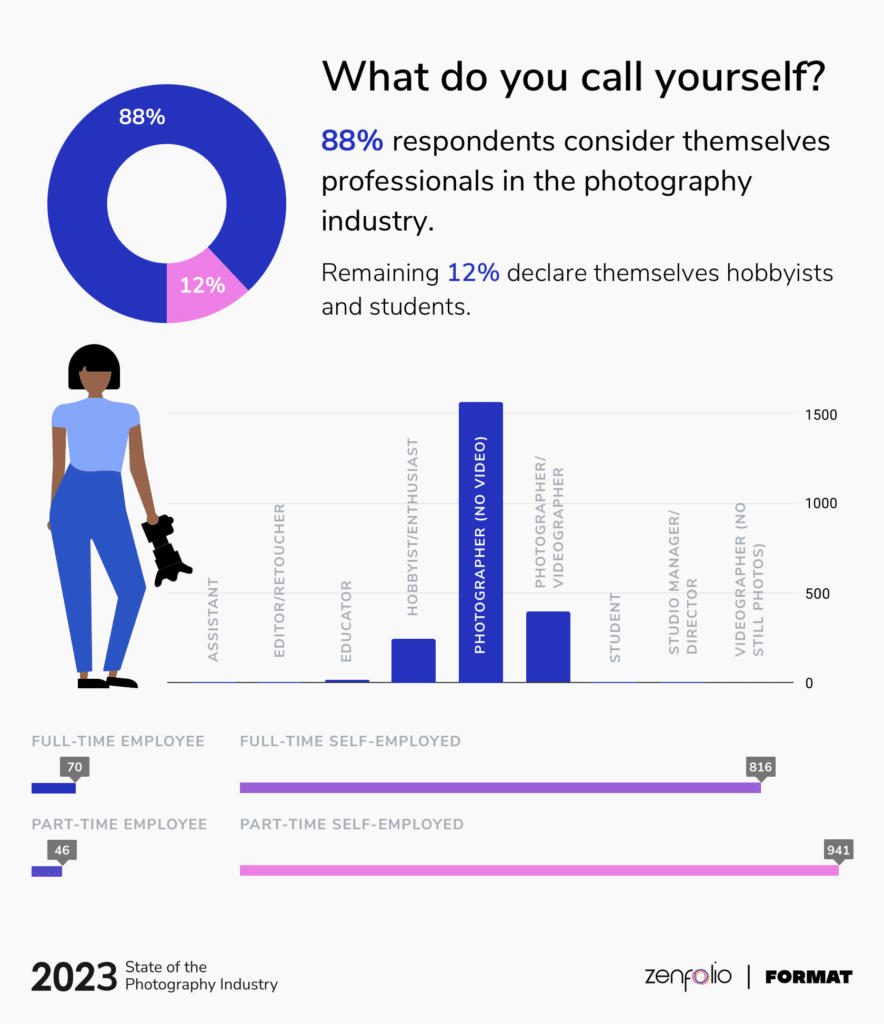
Nearly 50% of full-time self-employed photographers earn money in the primary specialties of Portrait, Wedding and Commercial. Portrait is also the top specialty for part-time self-employed followed by Landscape and Sports.
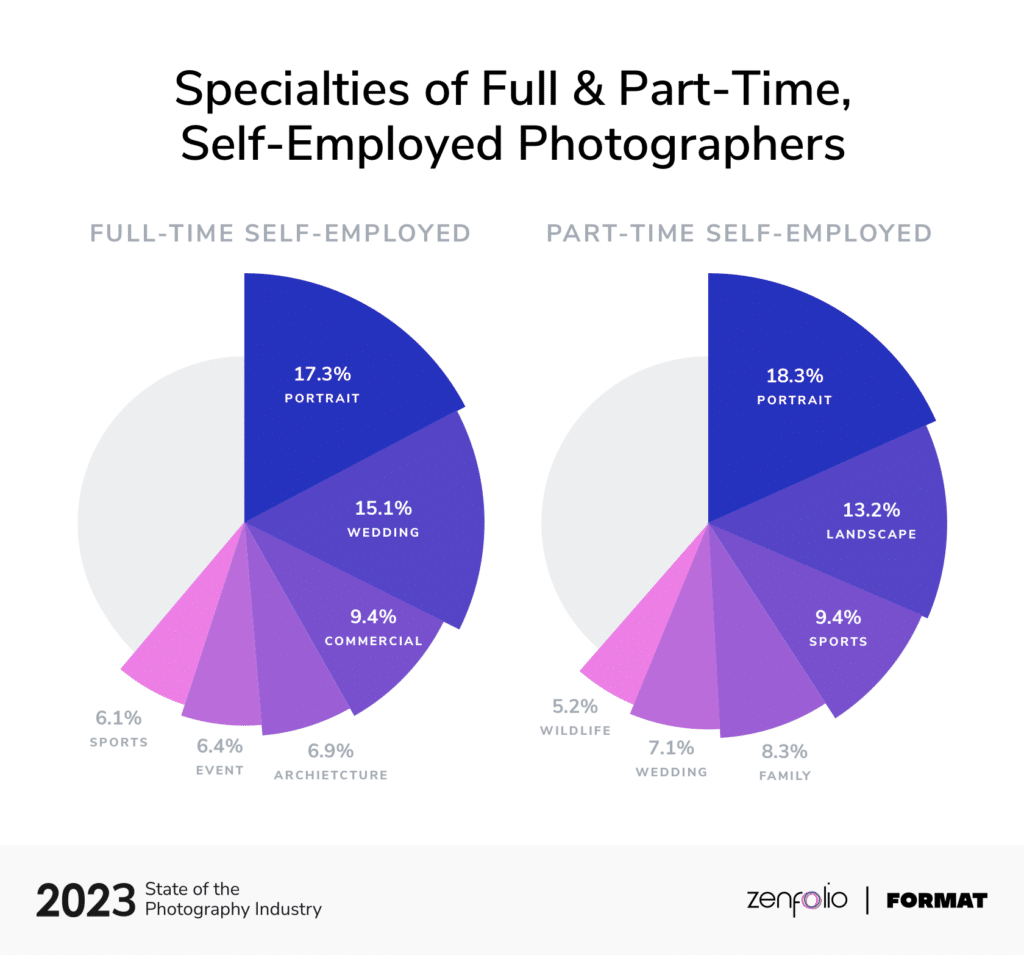
You could say respondents this year are a seasoned group – maybe even well-seasoned – with two-thirds of the total participants in the 40-69 age group. 65% have more than 10 years experience and 19% have been in photography 6-10 years.
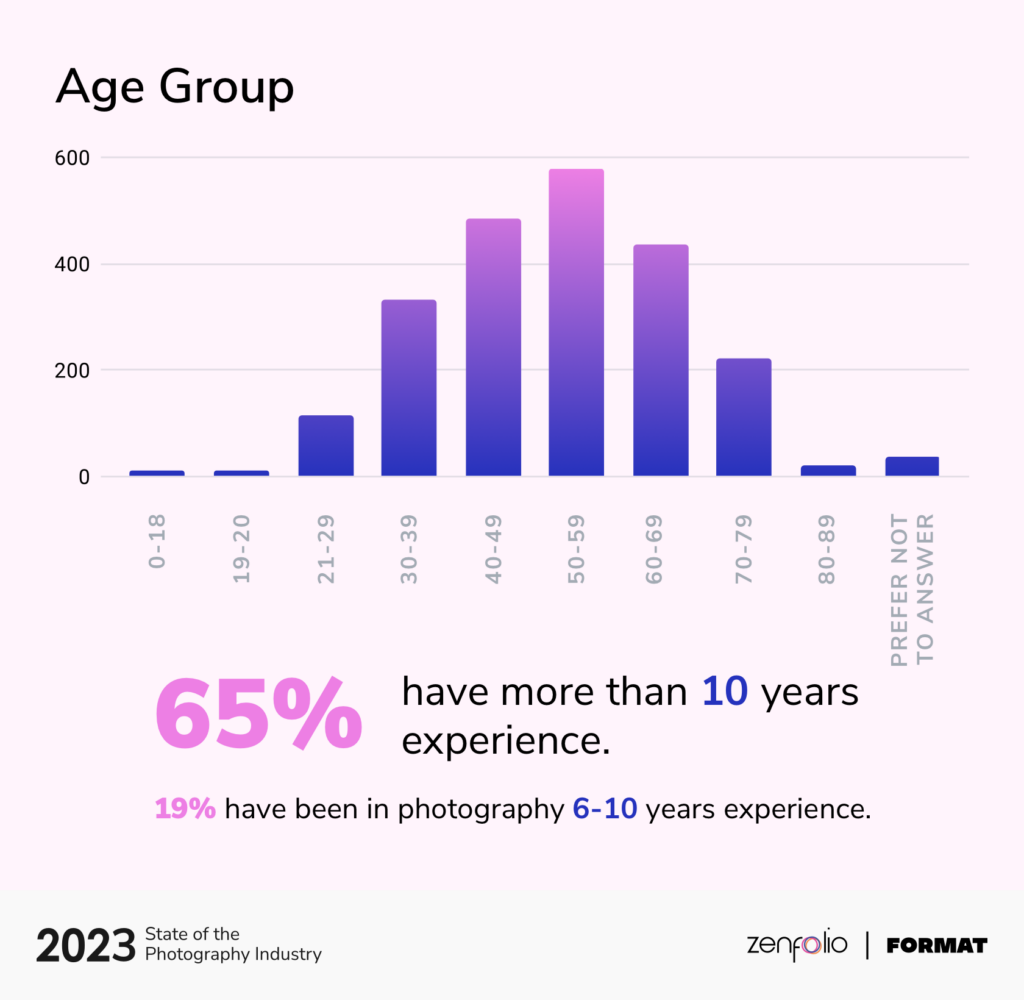
Going by the exclusive title “Photographer (no video)” dominated the results this year by a whopping 70% with only 17% classified as a “Photographer/Videographer.” This is a shift from the previous year’s survey when 65% said they shoot only still photos and 34% a mix of still/video.
What’s your photography specialty?
The photography industry has a wide range of focus areas or genres, and the survey covered 33 different areas of expertise. Among them, the top five photography specialties (in order) based on the survey results are:
- Portrait
- Landscape
- Wedding
- Sports
- Family
Compared to the previous year’s survey, the top three are the same, but in 2021 they were followed by a tightly bunched group of Fine Art, Events and Sports specialties.
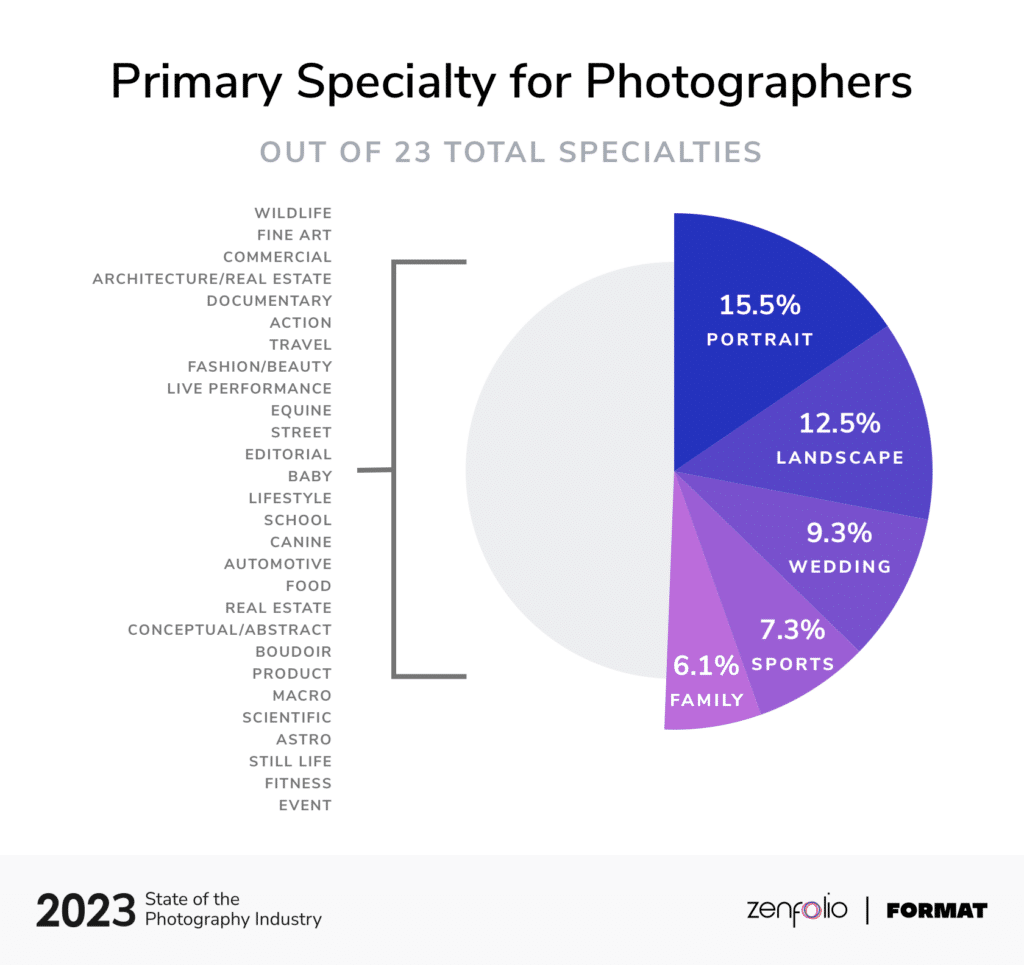
What’s the go-to gear for still shots and video?
For decades, professional photographers have relied on DSLRs (digital single-lens reflex) cameras as their primary tool to capture stunning still images. However, with the rapid advancement of technology, photographers now have a wider range of choices beyond the traditional DSLR. In recent years, mirrorless cameras and even smartphones have started to gain popularity in the professional photography world. Let’s explore the use of DSLRs, mirrorless cameras, and smartphones among professional photographers in the survey for still shots and video.
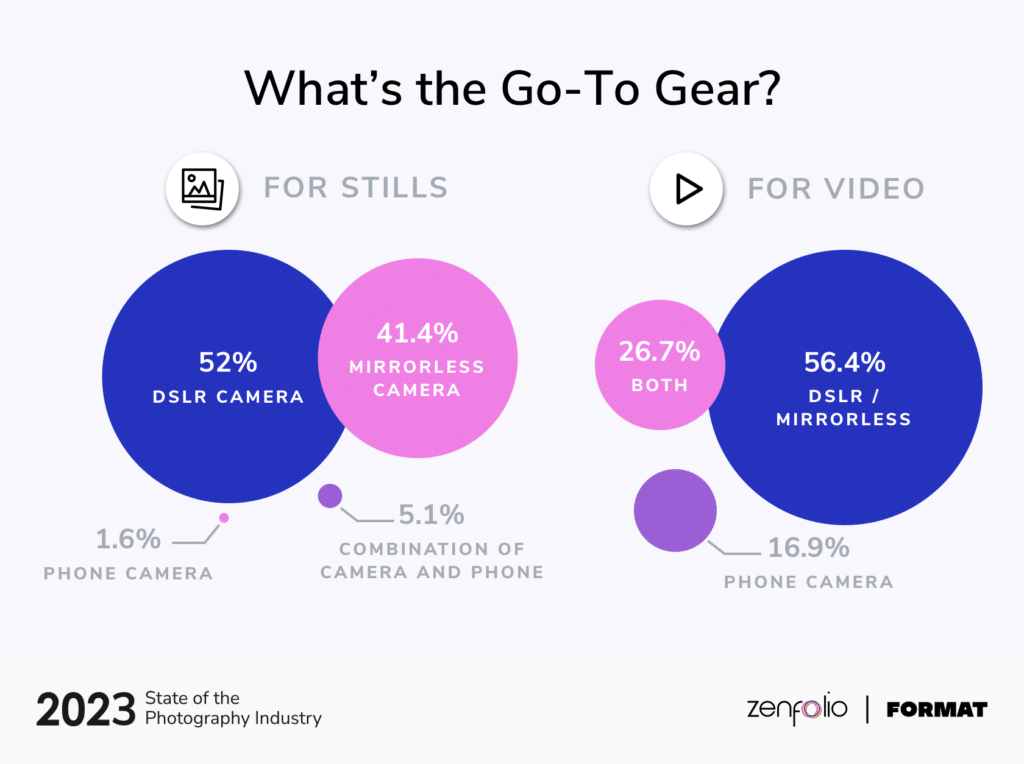
Based on the survey data, DSLRs are still the most commonly used tool among professional photographers for still photography, with 52% of respondents using them as their primary camera. However, mirrorless cameras are quickly gaining ground, with 41% of photographers choosing this option. This is a 50.7% increase in mirrorless camera usage from the last survey. It is also interesting to note that both DSLRs and mirrorless cameras are commonly used for video, as well as smartphones. This suggests that while DSLRs are still the top choice for many professional photographers, the rise of mirrorless cameras and the increasing capabilities of smartphone cameras are posing a real challenge to their dominance.
Marketing: How and where photographers promote their business.
Digital technology and social media platforms have provided more ways than ever for photographers to market their business. Websites, blogs, Instagram, Facebook, TikTok and other platforms enable showcasing portfolios and services to reach a wider audience. Marketing strategies have shifted. Photographers are relying more on non-paid or organic social media over paid ads for marketing their businesses.
This first chart indicates that 100% of Real Estate photographers in this survey say they market themselves, followed closely by Conceptual/Abstract and Boudoir photographers. The smallest specialty group was School photographers at 67%.
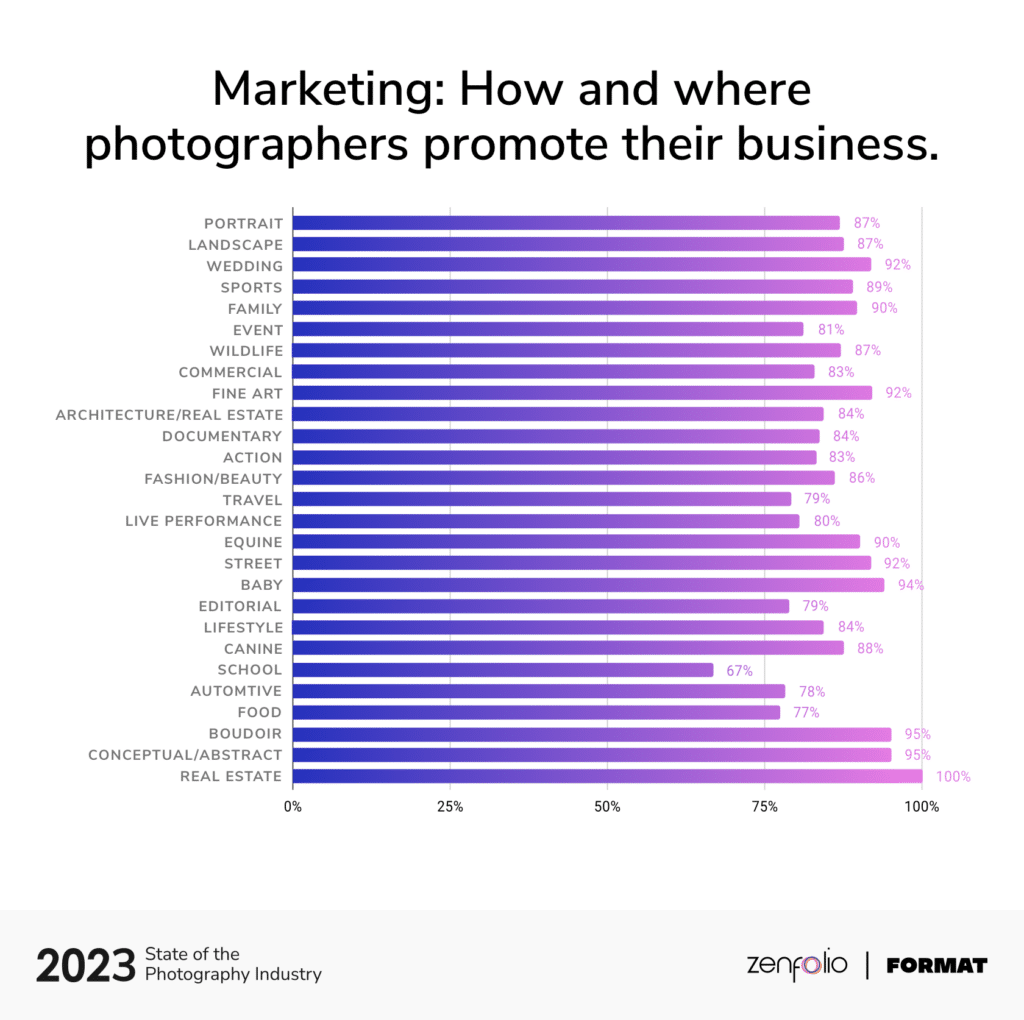
Old-fashioned Word of Mouth tops the “How” of marketing when looking at all specialties combined, with Instagram leading the digital platforms. (Note that SEO is defined as blogs, metatags, sitemap, keywords, links.)
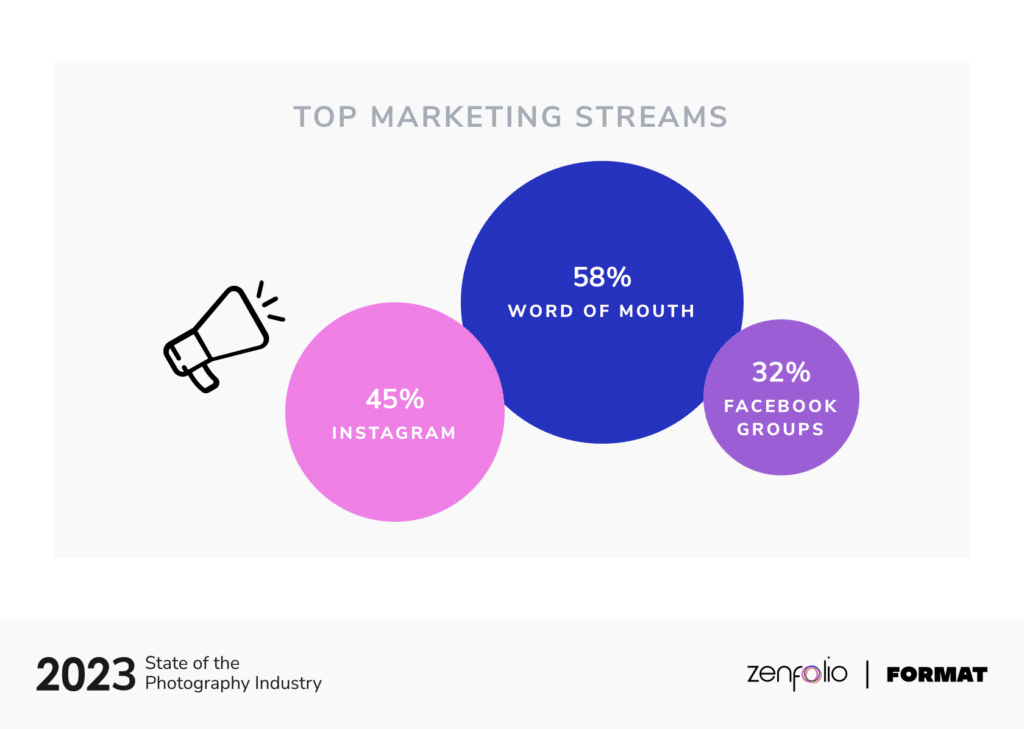
The results are flipped for Fashion and Beauty with Instagram used significantly more than Word of Mouth…and a much higher use of TikTok than other specialties.
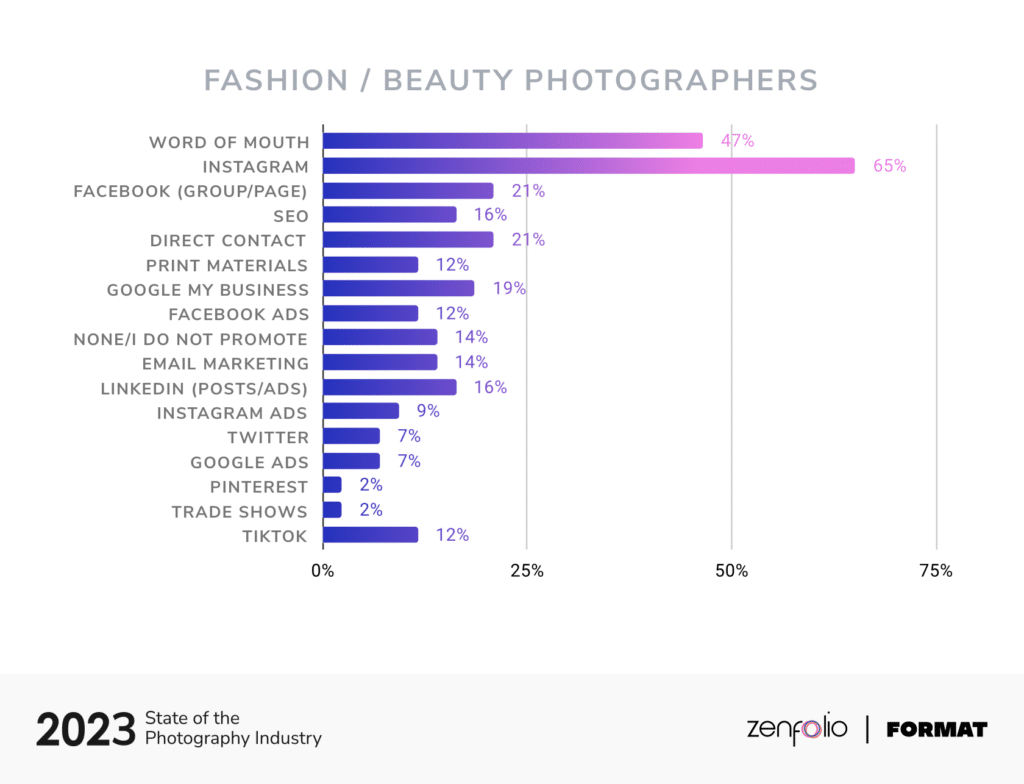
This year’s survey reveals that spending time or money at Trade Shows is really not popular as photographers use much easier and cost-effective ways. In fact, several categories indicated zero participation here. Wedding and niche photographers for Equine and Canine use Trade Shows, but it is still not a significant portion of their marketing tactics.
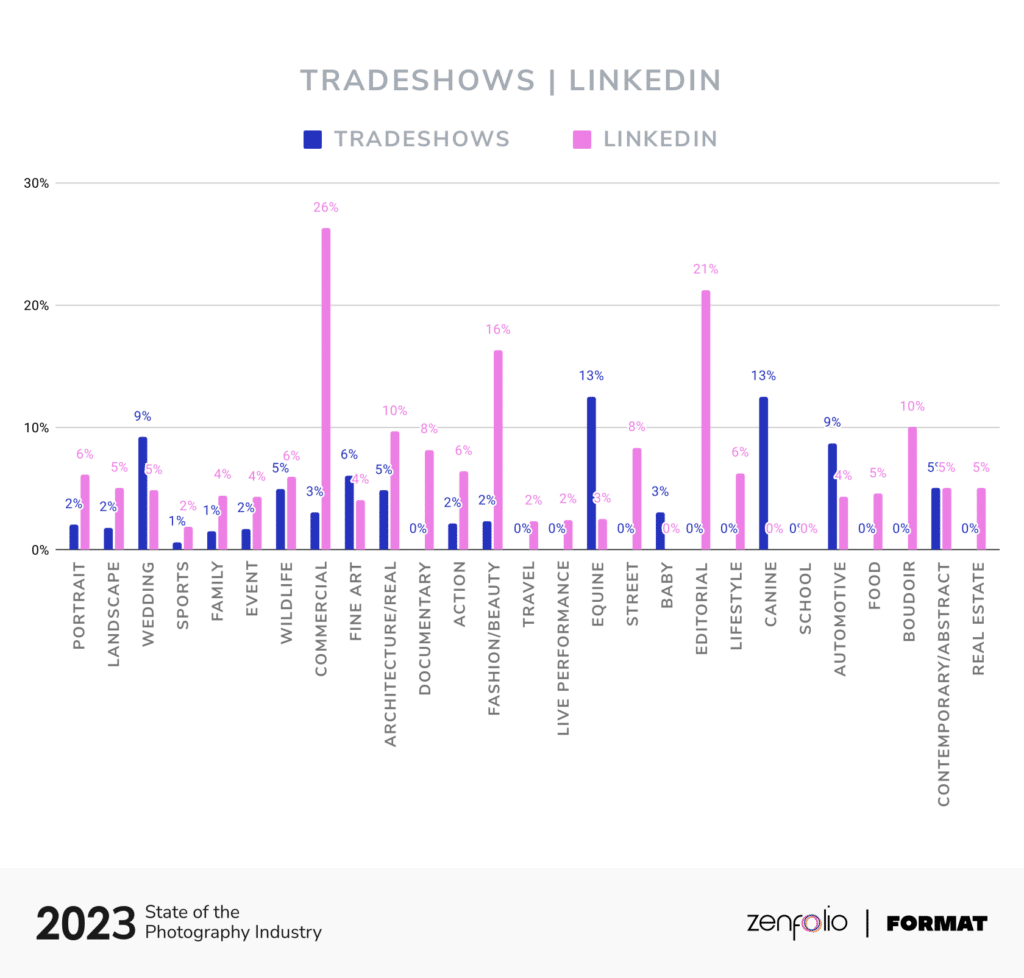
Photography businesses that cater to B2B (Business-to-Business) markets, such as Commercial, Fashion/Beauty, and Editorial photography, typically provide services to other businesses rather than to individual consumers. These client businesses require specialized photography services to market their products, promote their brand, or document their operations. Because of their business model, the B2B photographers use LinkedIn at a greater level than B2C (Business-to-Consumer) photographers.
B2C photography businesses, such as wedding or family portrait photography, typically target their marketing at individual consumers. These photographers still rely heavily on Word of Mouth, but also use social media platforms like Instagram or Facebook to showcase their work and reach potential clients.
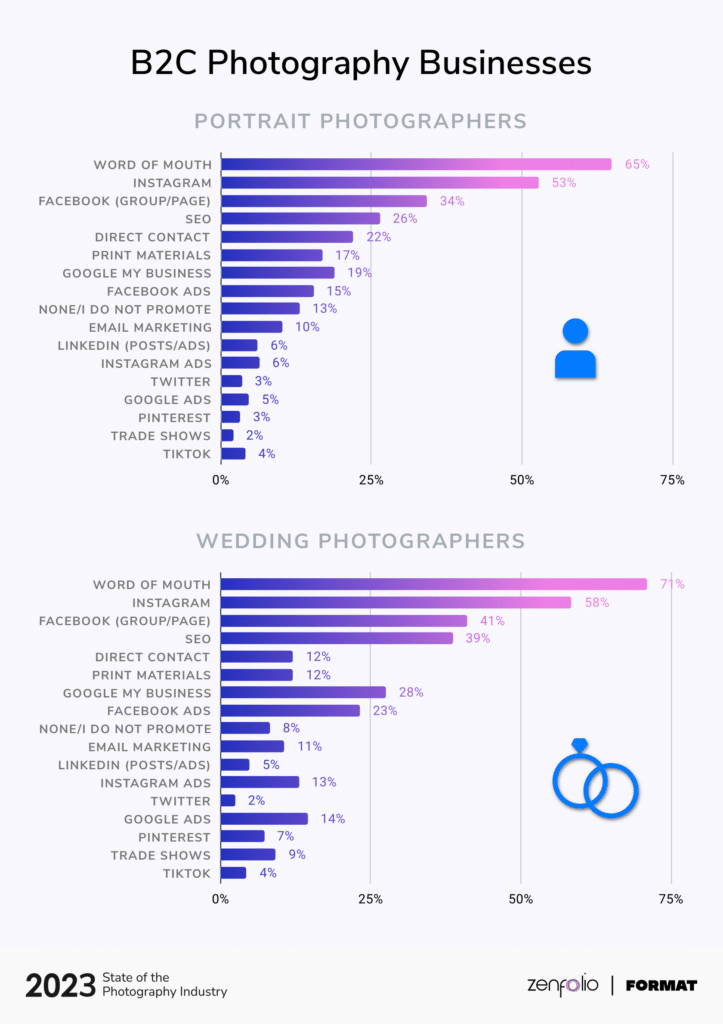
An analysis of photographers by revenue level and how they spend their time and money marketing indicates that even the lowest income generating photographers are trying just about everything. At both ends of the revenue spectrum, photographers surveyed say they rely most heavily on Word of Mouth.
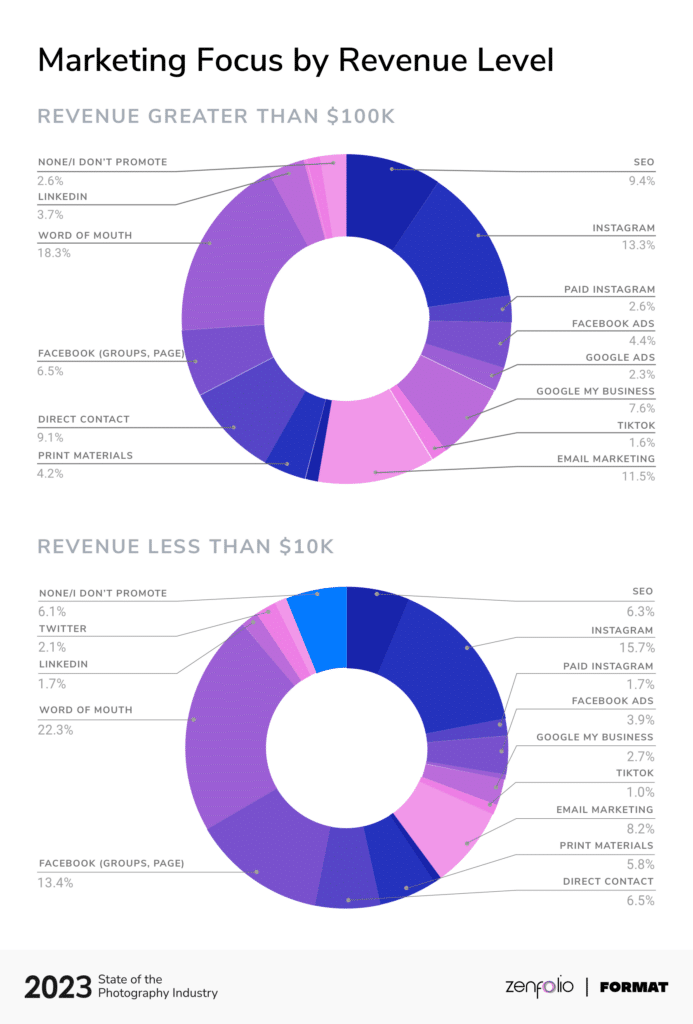
Organic marketing refers to the use of non-paid, non-promotional tactics to drive traffic and engagement to a photographer’s online presence. If we look at organic digital marketing by combining Instagram, Facebook, LinkedIn, TikTok, SEO, LinkedIn, Twitter, Pinterest, and email marketing, and compare it to paid digital marketing, we see that photographers invoicing over $100k a year focus 86% of their efforts on non-paid digital marketing. The ratio is about the same for those with revenue less than $10K.
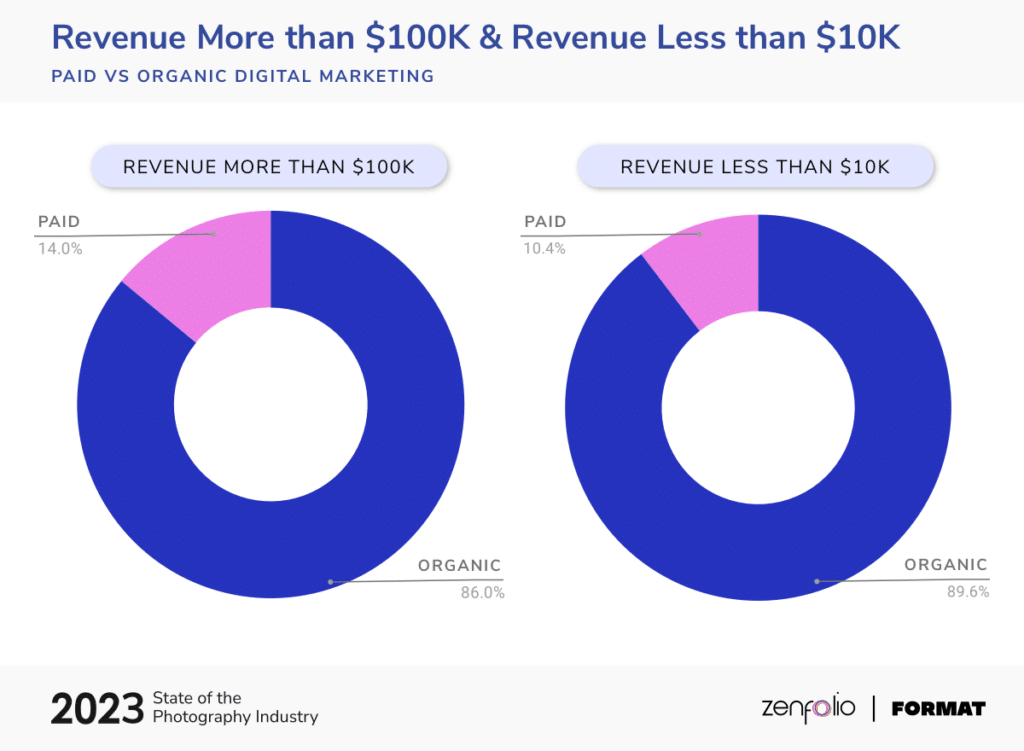
For photographers with revenue over $100K in revenue, paid Facebook Ads are utilized by nearly a 2:1 margin over paid ads with Google and Instagram, yet for those with revenue less than $10K, Google Ads are a distant third.
So…how’s business?
In last year’s survey, only 11% expected business to slow down in 2022, but now that the year has come and gone, the reality was different. Even though the largest single reporting group in the new survey claimed business was actually slower than expected in 2022, about 47% said business was about the same or busier than expected. 5% opened their new business, while 3% closed up shop in 2022.
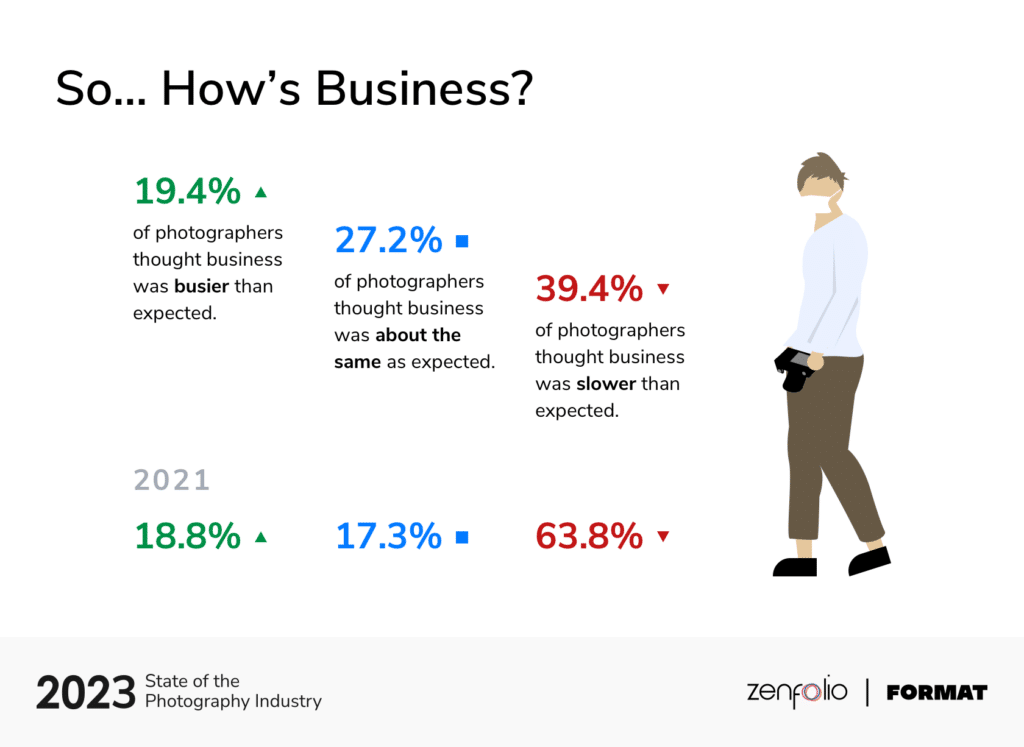
The economic effects of the Covid pandemic persisted for the photography industry throughout 2022 with 55.4% reporting that Covid played a role in reducing their revenue. Just over 10% said their revenue increased during the year.
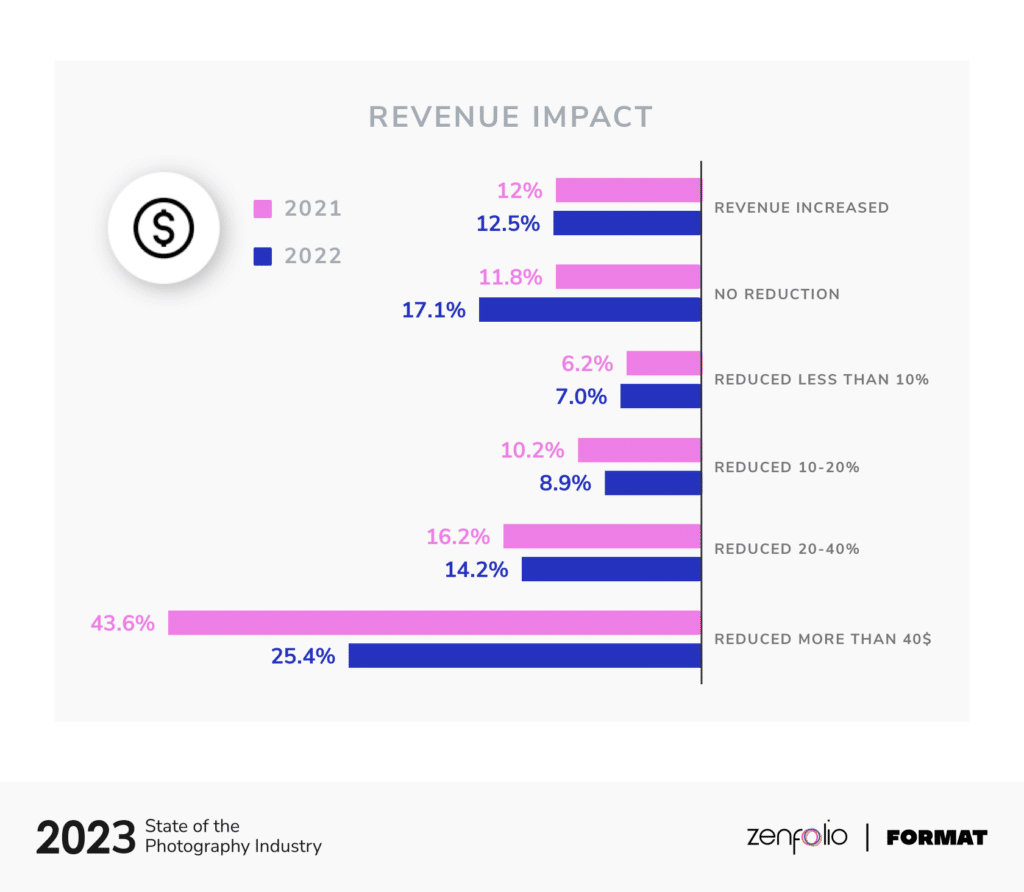
Nearly 60% of respondents said that Covid did not impact the products or services they offered in 2022.
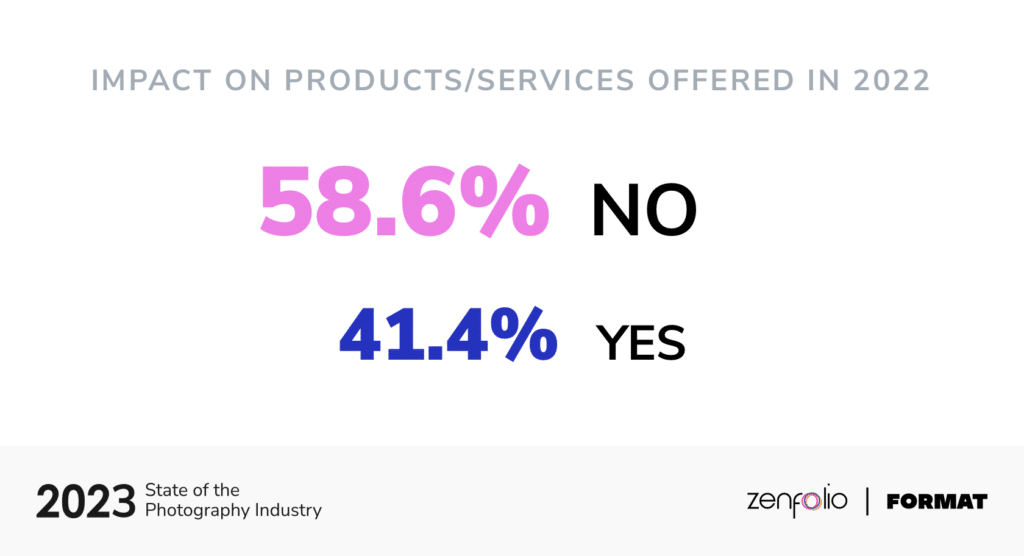
As global inflation lingered over 2022, the largest single group of survey participants said their monthly costs rose 6-10%, followed by a group saying they “don’t know” if their costs rose. 16% said their monthly costs rose by more than 15%. A third of the survey said they did not raise prices during the year, and another third said they raised prices between 2-10%.
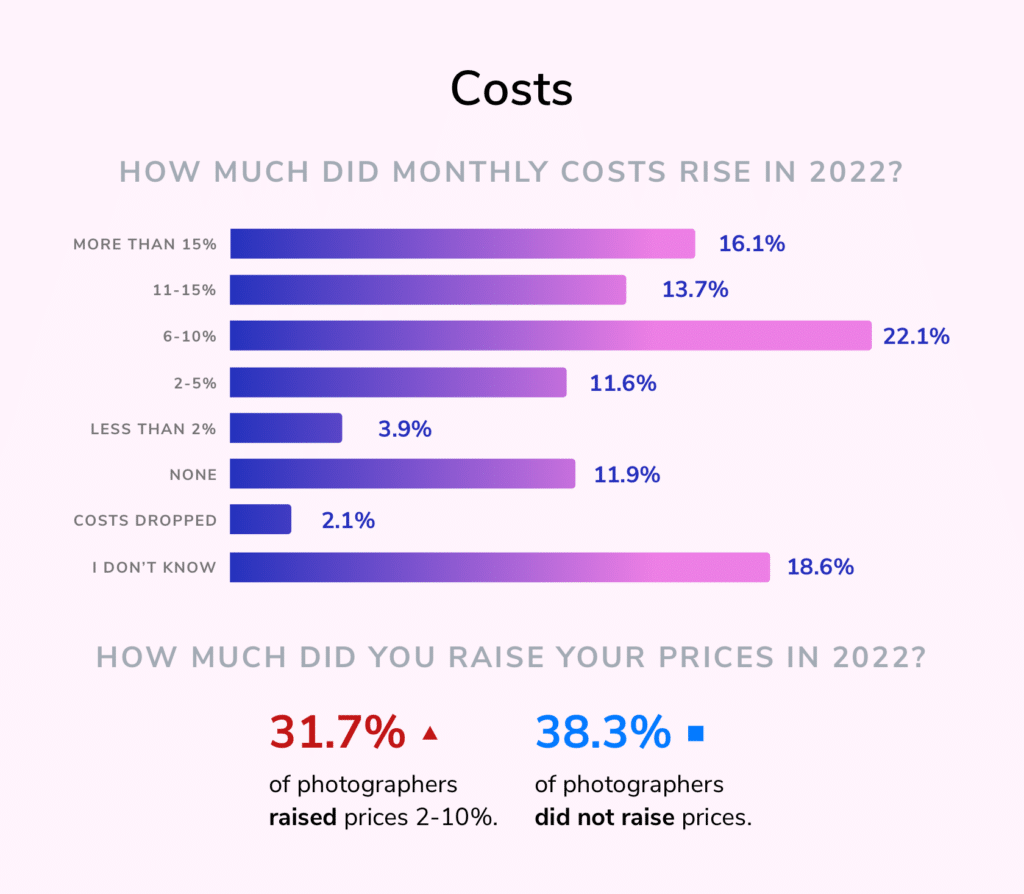
Looking forward, photographers remain cautiously optimistic about 2023 with just 7% expecting a decline in revenue and over 75% projecting business to remain steady or get busier – that’s a little less optimistic when compared to 89% expressing the same sentiments in the previous year’s survey. For 2023 business, the caution comes from 17% who say they just don’t know what to expect.
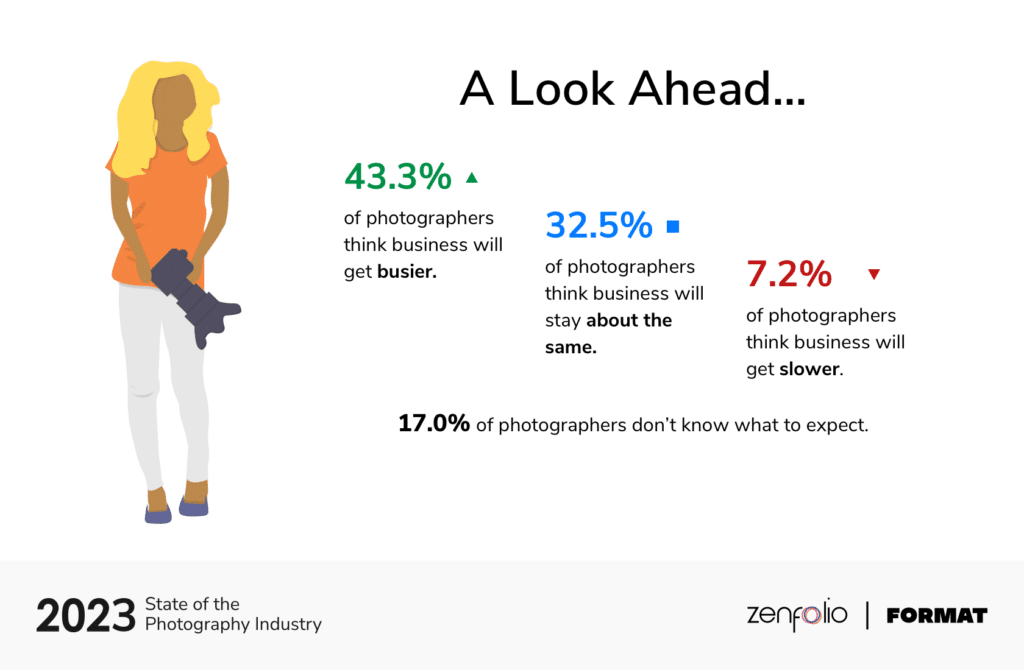
A deeper dive into revenue and income.
At first glance, it might be less than encouraging to see that 57% in the survey make less than $20K gross income per year, but this number reflects the largest Work Status group we saw earlier who declared themselves as working part-time, and the small slice of full-time employees who work in various supporting roles.
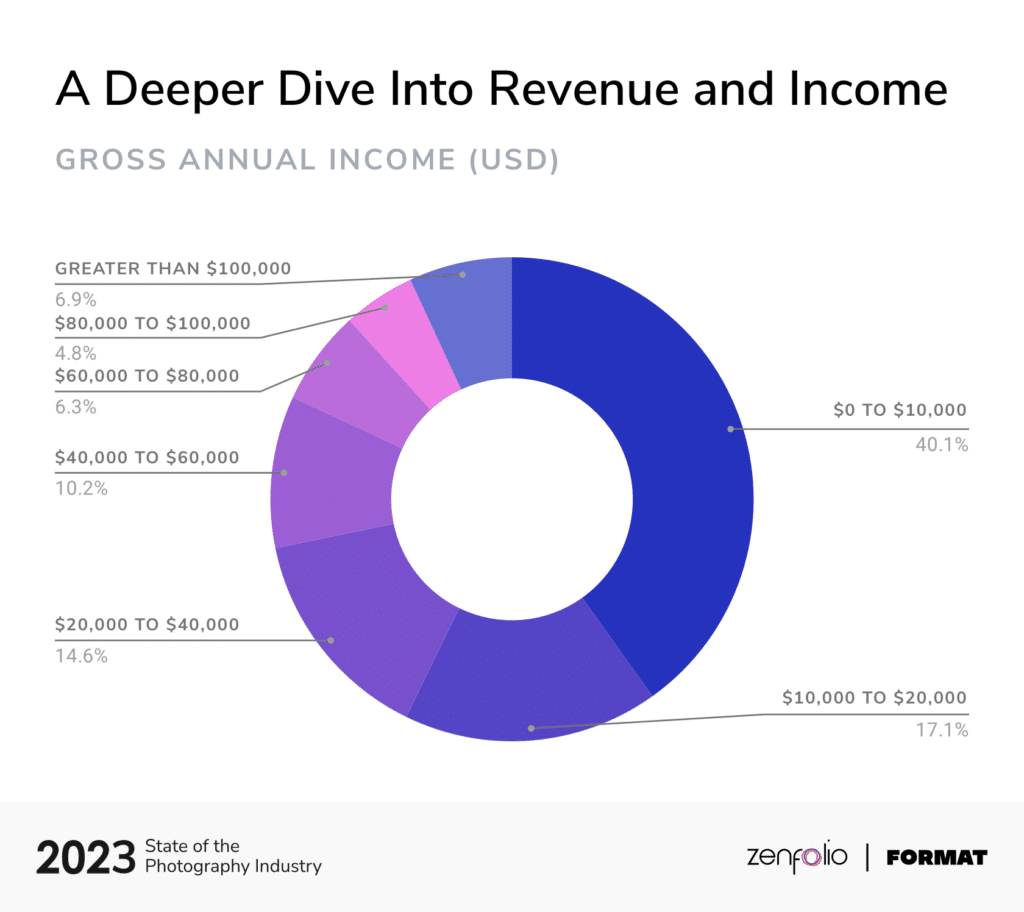
It is more encouraging to see that the largest group earning over $100K per year are the full-time self-employed…by far at 95%. Where are these big earners? Most are in California, followed by Texas and Georgia.
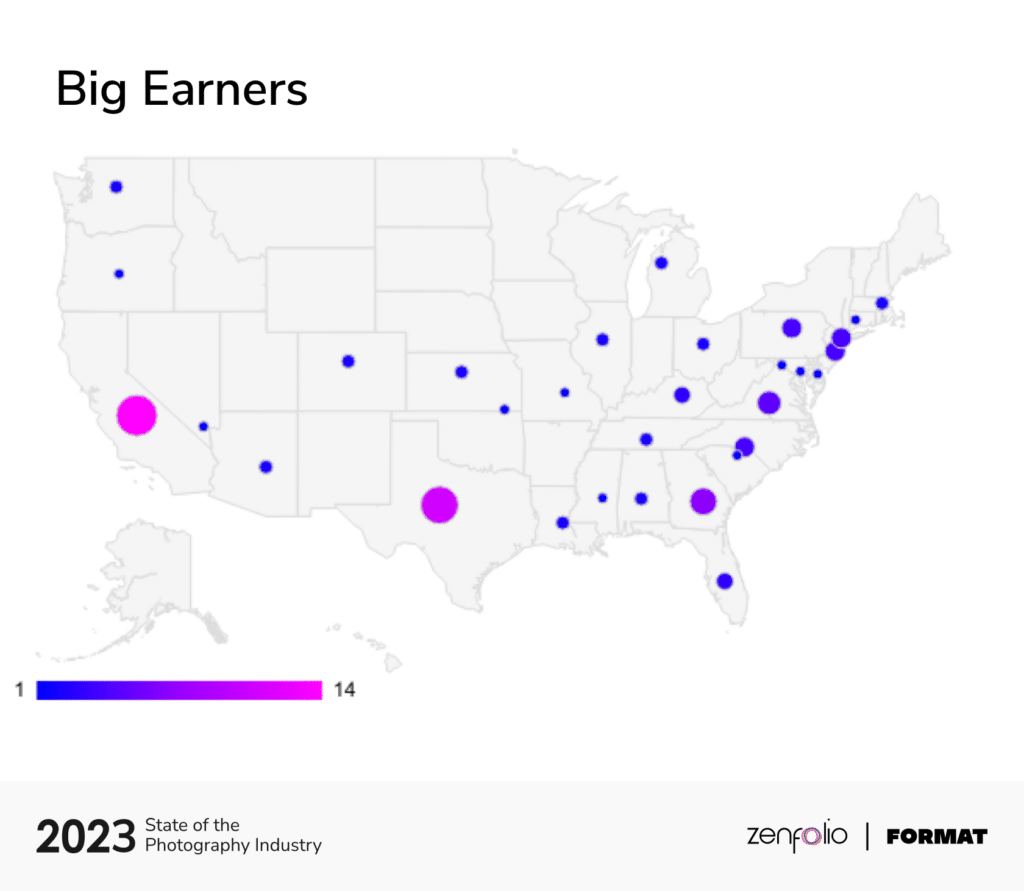
But not all full-time self-employed photographers are pulling in six figures. A look at gross annual income for full-time self-employed shows the largest group making between $40K-$60K, with 43% earning between $40K-$100K.
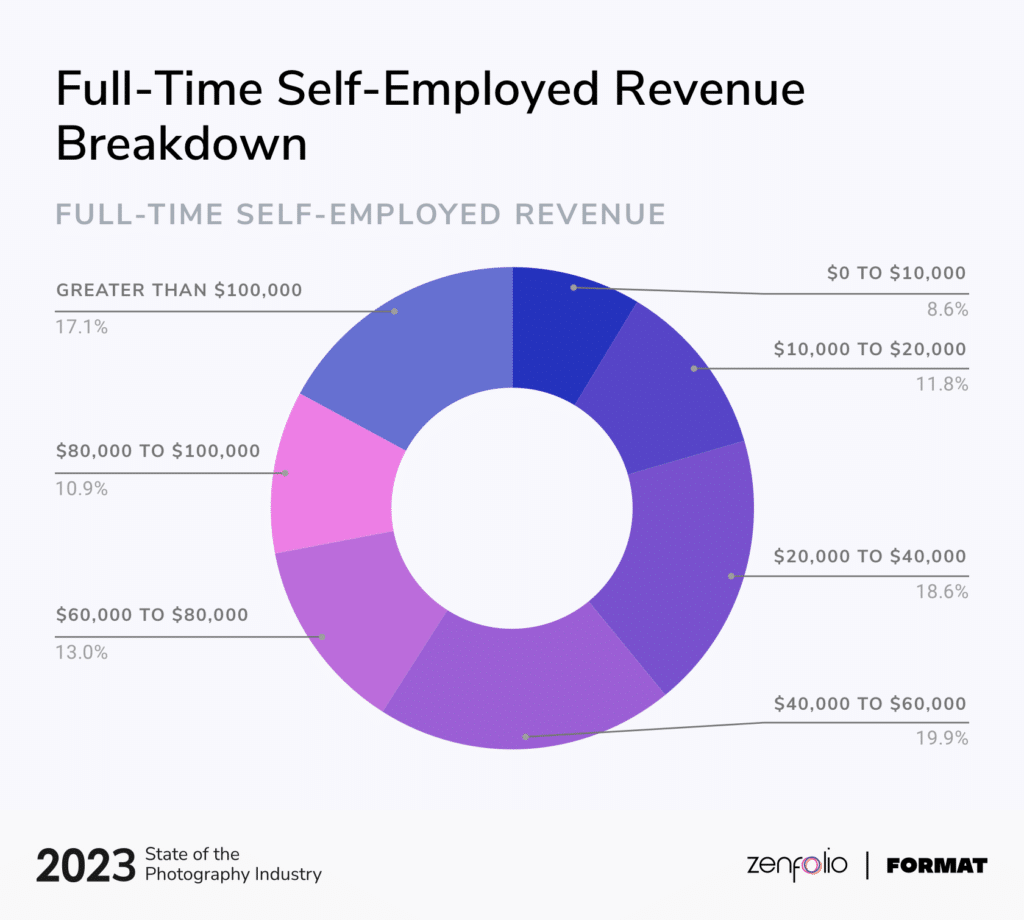
Which specialties are generating revenue over $100K as full-time self-employed photographers? Portrait, Wedding, and Commercial genres comprise over 50% with Event and Architecture rounding out the top five.
Who are these biggest earners in photography? A closer look shows that experience pays with 73% in the 40-69 age group and 87% report more than 10 years experience. About 3/4 of the group are male.
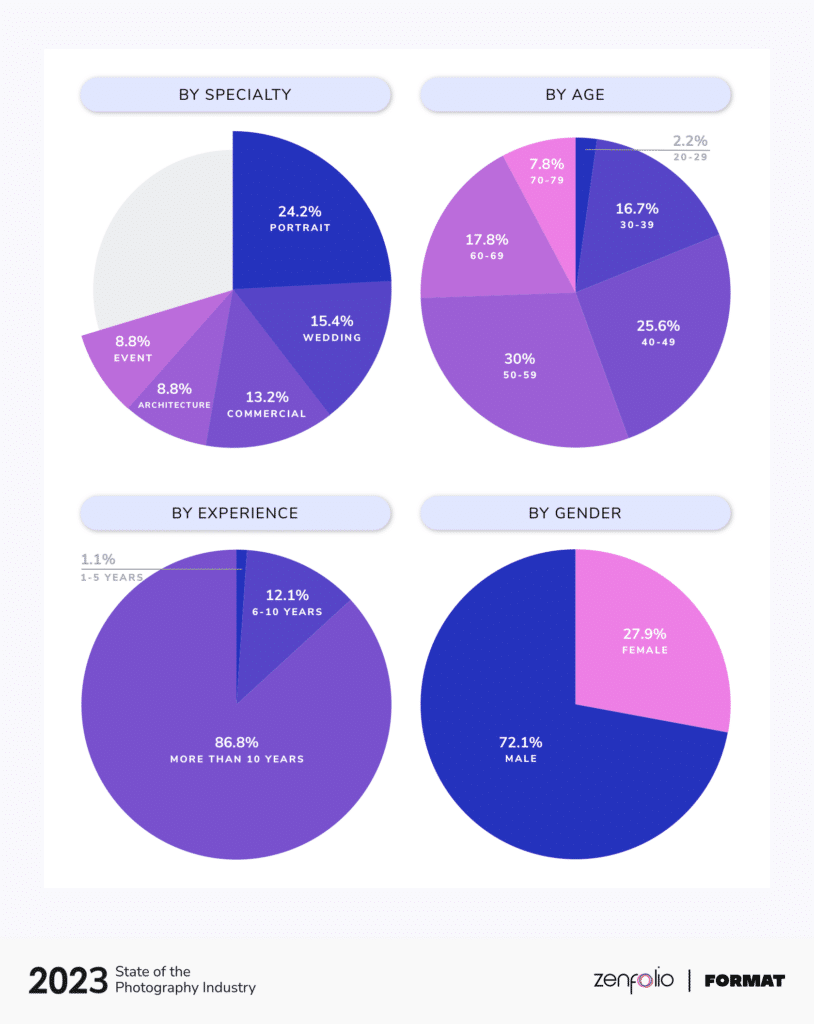
How and what do you sell?
It’s the million dollar question in the entire survey: how do you charge for your services? By far, most charge by the package, followed distantly by the hour, then by the day/event. Let’s take a look at how these answers further break down.
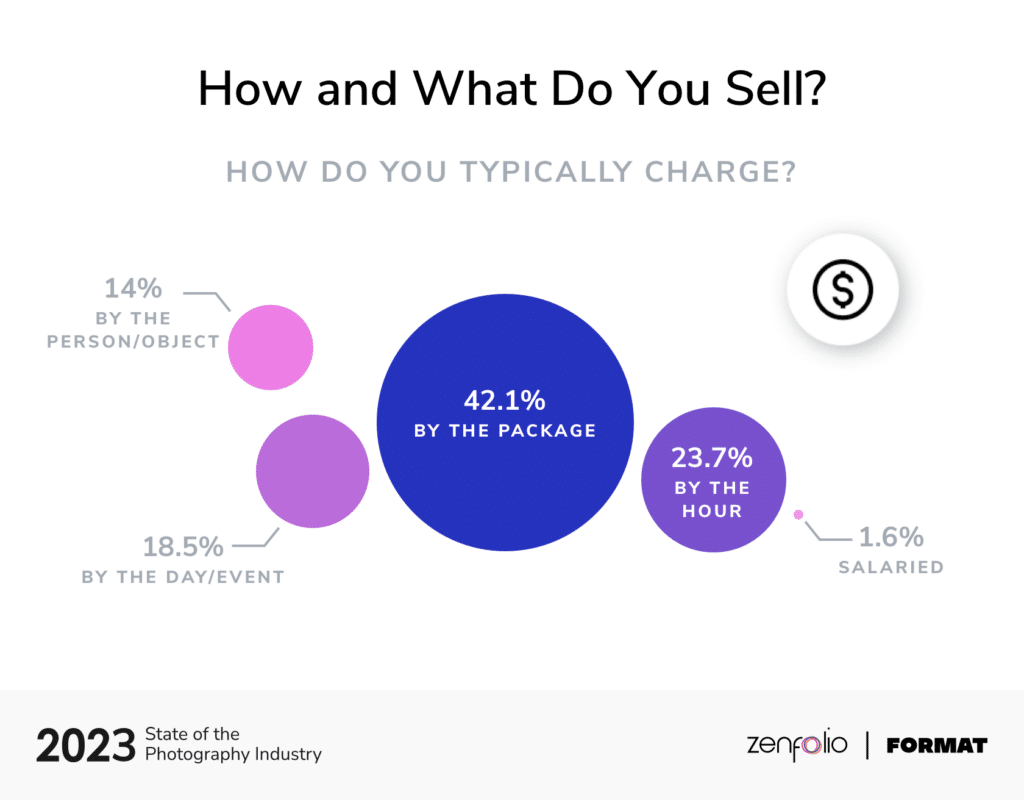
By the package:
The most popular package type includes the session/shoot with only digital products or files delivered to clients – no prints. The second most popular type of package adds prints in addition to digital deliverables. Packages comprised of a session with only print products came in at a very distant third place.
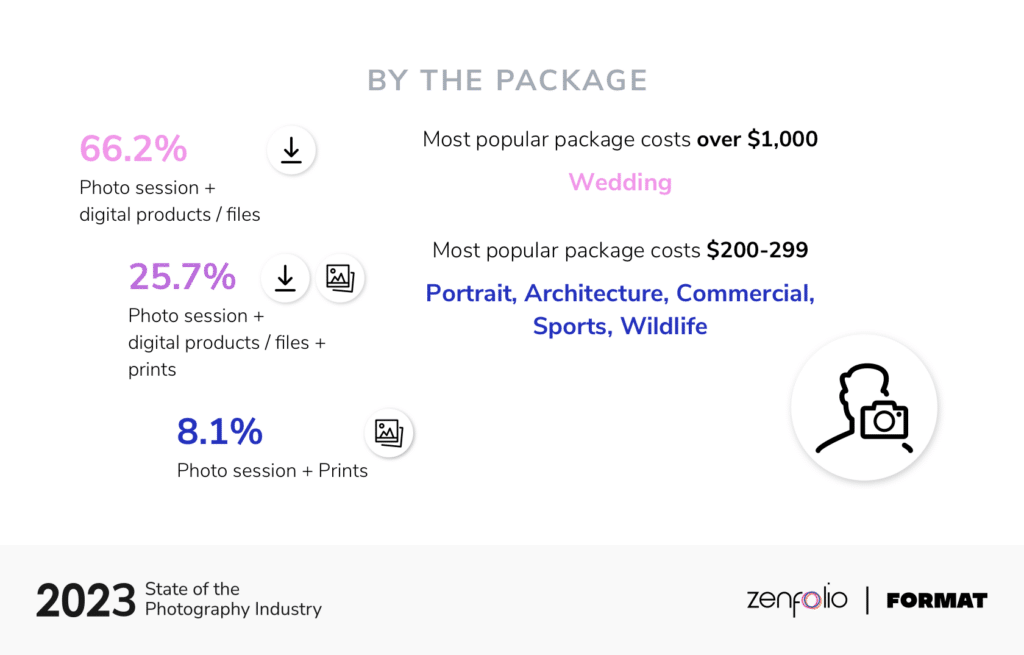
Photographers told us that their most popular packages cost $1,000 or more, but it’s important to note that this is strongly influenced by wedding photographers. 50% of those who said they charge $1000 or more per package were wedding photographers.
The second largest group of package prices is $200-$299. Maybe it’s no surprise that no wedding photographers are represented in this price range.
By the person/object:
As popular as packages are among the photographers in this survey, Family photographers tell us that they prefer to charge by the person/object. The more people in the photo session/group shots, the more they charge.
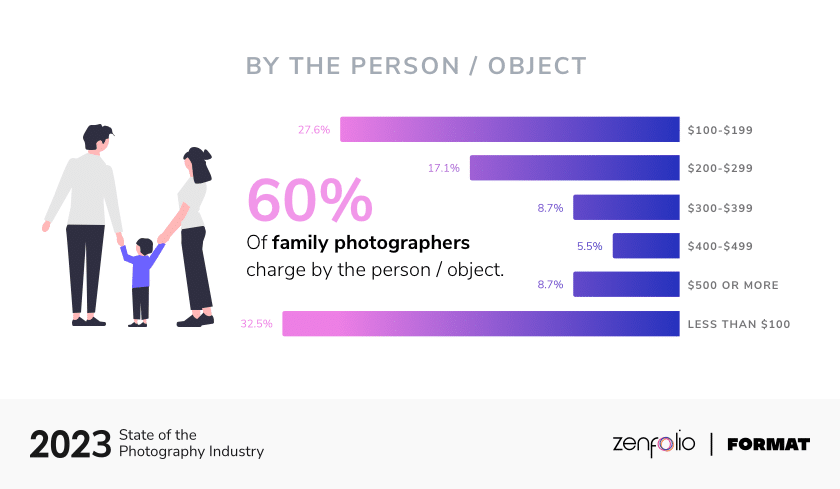
By the hour:
Almost half of photographers who say they charge by the hour charge $100-199 per hour. 20% charge $0-100 and about 19% charge $200-299.
By the day/event:
Of this group, the majority charge $1,000-1,999 with half of that sample size charging $300-399.
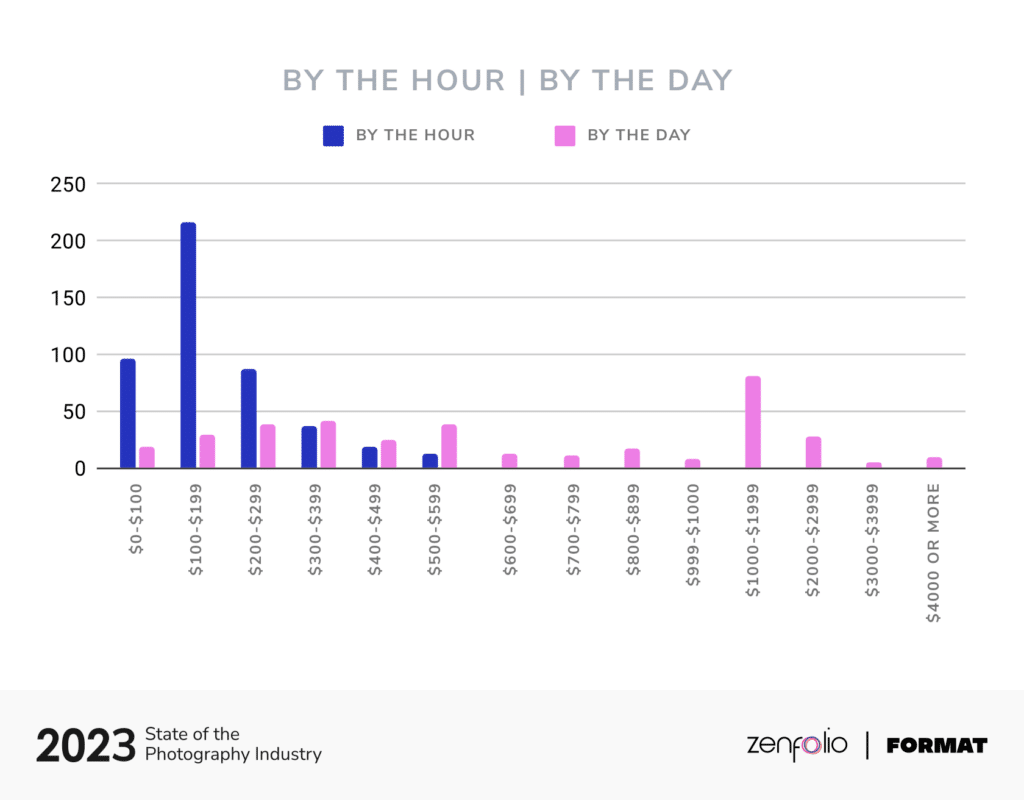
Pricing of products: print and digital.
How do you value digital files?
How are photographers selling prints and digital downloads? Let’s start by addressing the debate around whether digital files should be valued more or less than traditional prints.
Some photographers take the side of digital files as valuable assets that should be priced higher than prints because they can be used in a variety of ways including postings on social media, websites, and advertisements.
The other side of the debate posits that digital files should be priced lower than prints because they do not require the same materials, printing processes and in some cases, crafting, as traditional prints.
So how many photographers in this survey sell digital files outside a package and what do they charge? The ratio is about 50/50 with slightly more than half saying they will sell individual downloads with the vast majority being high-resolution.
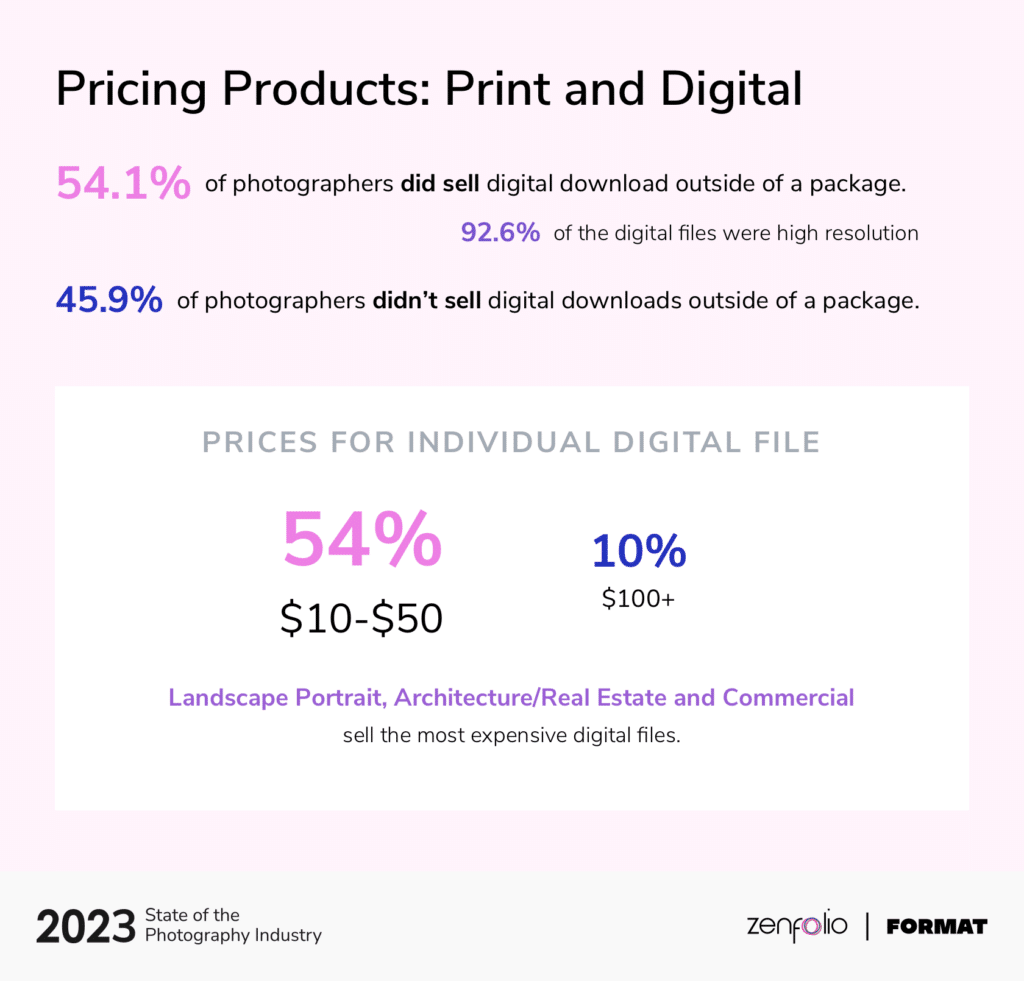
54% charge between $10-$50 for an individual file with 10% selling individual files for more than $100. Landscape, Portrait, Architecture/Real Estate, and Commercial specialties sell the most expensive digital files.
The science and art of pricing prints.
Yes…the good ol’ 8×10 print is still a thing even though packages, especially with digital downloads only, are popular with photographers. 71% of the survey group say they do sell individual prints and they are mostly priced at $10-20 each.
The formula for pricing prints can vary widely by photographer and might contain all kinds of elements – paper or other materials like canvas or metal, lab options, color filtering or effects, even framing. And even though digital files are more popular, great prints that beautifully showcase an image are still a valued treasure by many clients.
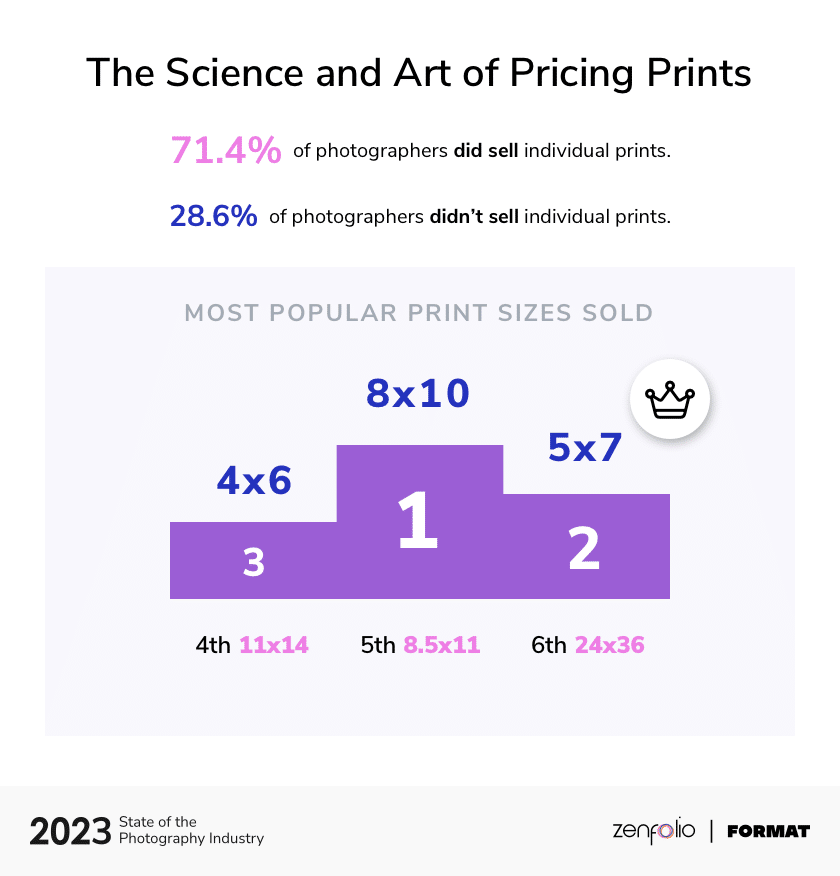
Pricing of 8x10s.
The 8×10 print is the most popular print size offered by photographers in this survey and it’s also the print size that is most commonly used by prospective clients to compare pricing.between photographers. According to the Joy of Marketing, “That little 8×10 is not just a product you sell, it’s the canary in the coal mine. It’s the #1 number your clients use to compare you with every other photographer, and it’s how you are measured against them!” Let’s take a look at how those who participated in this survey price their 8×10’s.
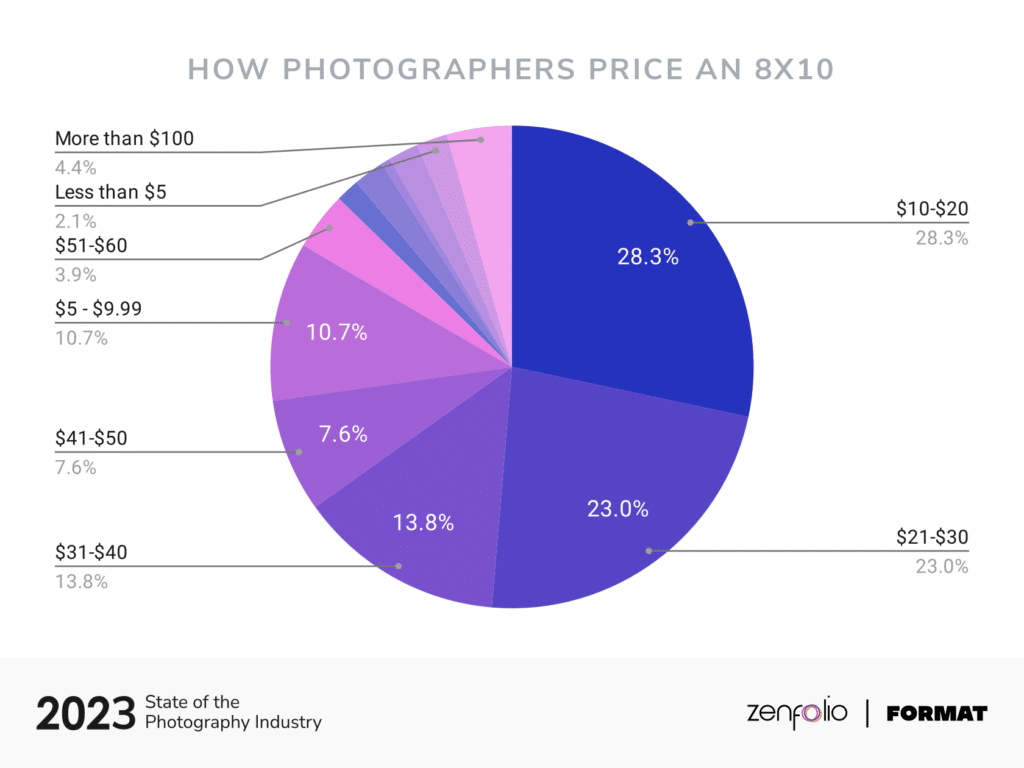
While only 4.4% of photographers surveyed said they charge more than $100 per 8×10, this segment is comprised of Portrait, Landscape and Fine Art photographers.
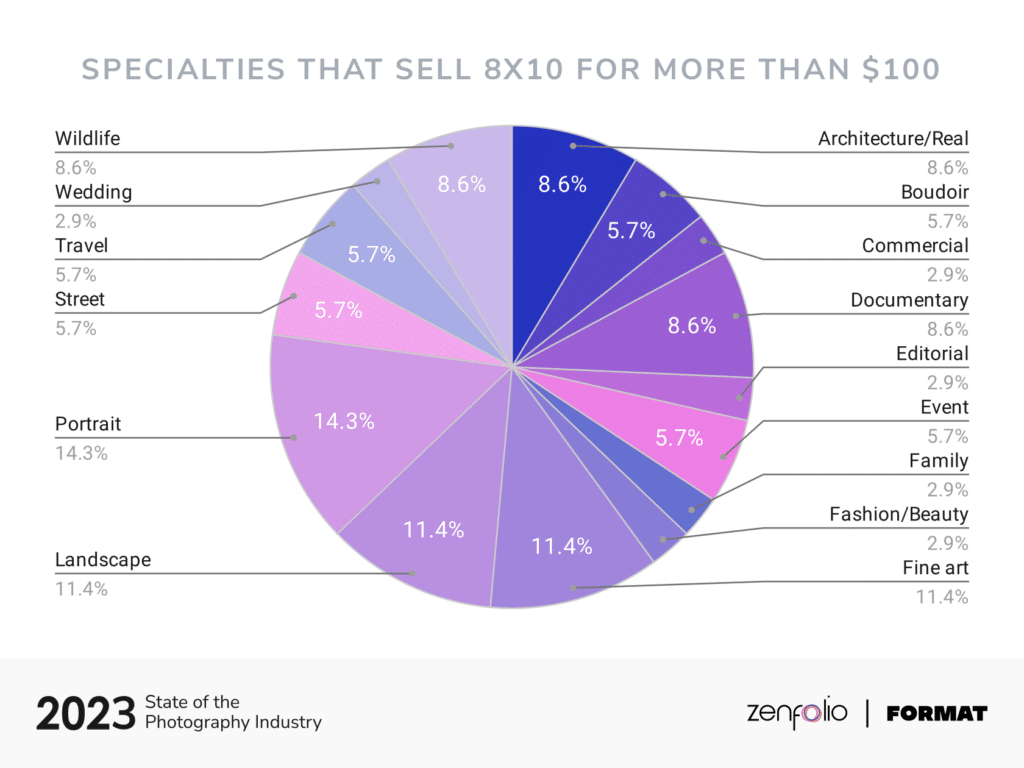
Wedding and Sports photographers surveyed say they sell 8×10 prints for less than $10 – more than other specialties perhaps due to the large volume of prints sold in these specialties.
What’s taking up your time?
Photography can be a passion and a hobby for many people, but for those who want to turn it into a profession, it involves much more than just taking stunning pictures. Running a photography business requires time spent on editing, marketing, branding, accounting, and customer service, among others. We see in this survey that many photographers are challenged to balance their love for photography with the demands of running a successful business. We asked photographers what the top three tasks are that they spend the most time on.
Many photographers who love their time behind the camera, don’t equally enjoy spending so much time after the shoot on time-consuming tasks like sorting, culling, or post-production editing, sharpening. Here we see the task photographers in the survey would like to spend less time on. Editing was the clear “winner” or should we say “loser”.
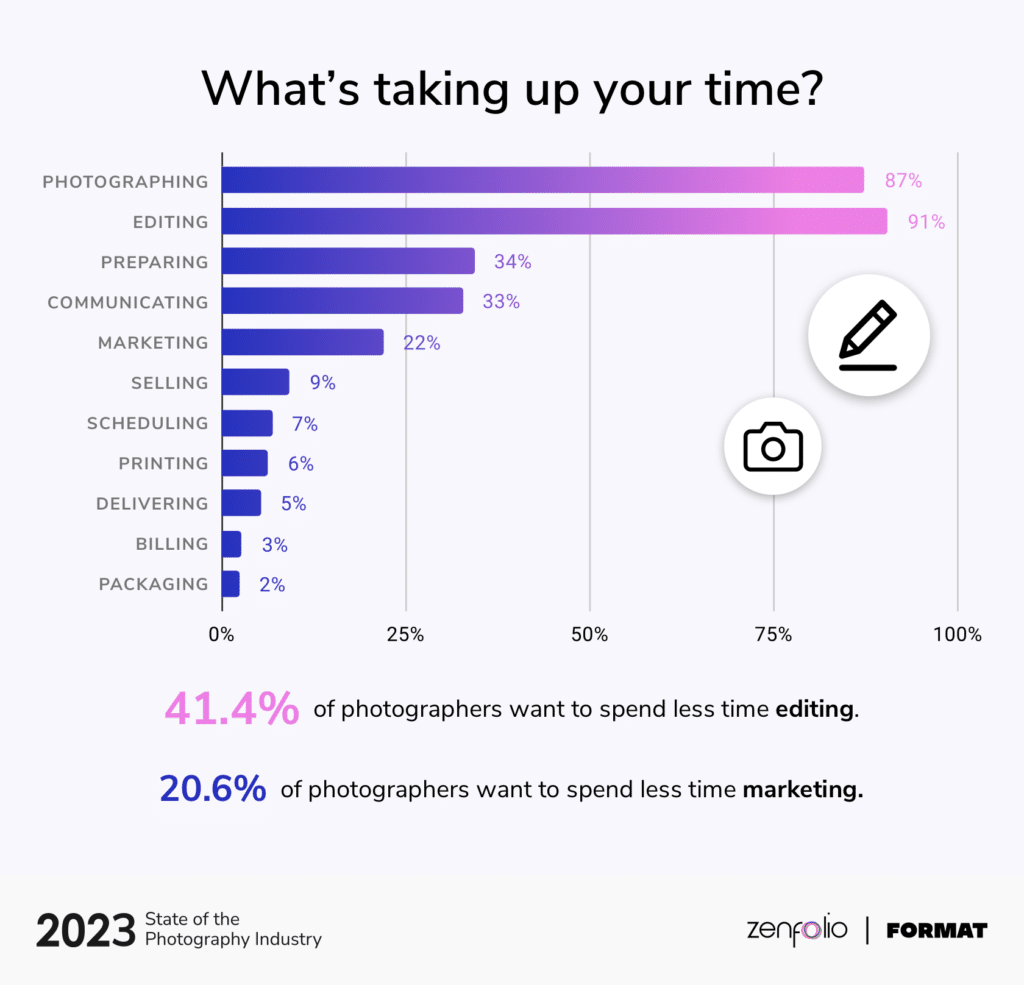
This survey provides valuable insights into the time allocation of photographers, with a clear picture that most photographers want to spend less time behind a computer. There is hope on the horizon in the form of AI. AI can now help liberate photographers from the dark corners of the office and get them back into the light with their camera.
Artificial Intelligence (AI): Are photographers using AI and how?
Over the entire span of the photographic arts era, it hasn’t been that long since photographers evolved from film and darkrooms to digital technology. Now that the AI age has arrived with virtually every type of business employing sophisticated technology to streamline workflow, photographers are no different. AI is controversial among photographers because it can automate certain aspects of the creative process, which some argue diminishes the value of human artistry and skill. Others argue that AI can enhance and expand the creative possibilities for photographers, while also streamlining workflow and improving efficiency.
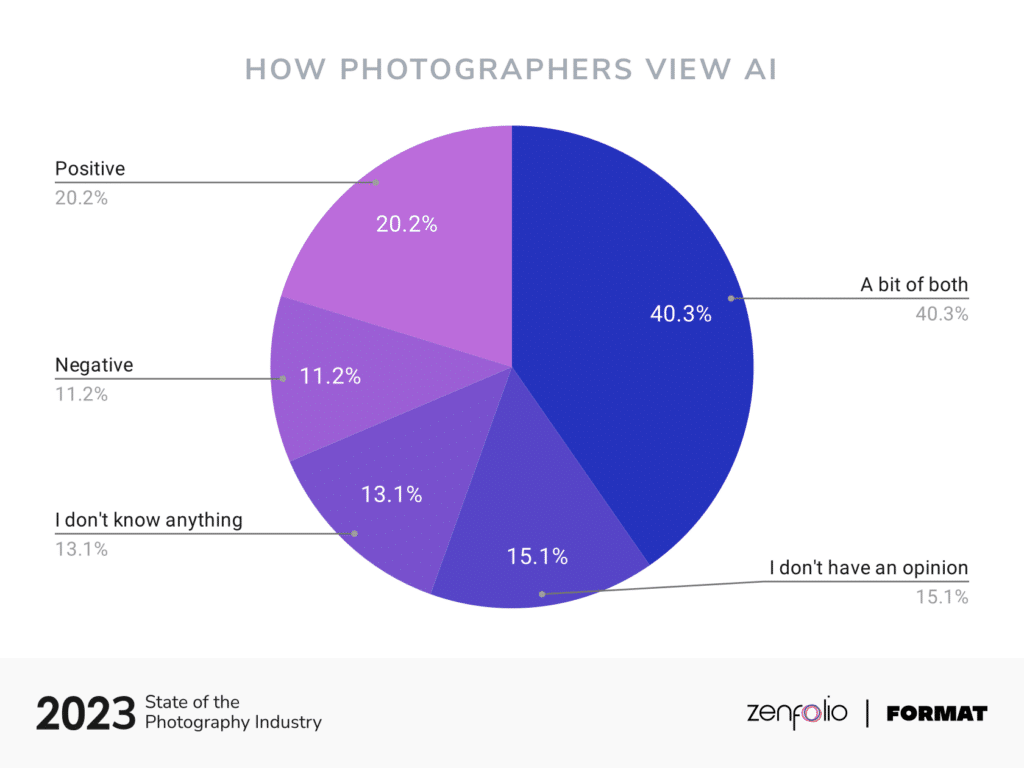
Although only 20% of photographers of those surveyed said that they felt AI was positive, almost 50% reported that they have integrated AI into their photography processes either as needed or as a part of their regular workflow.
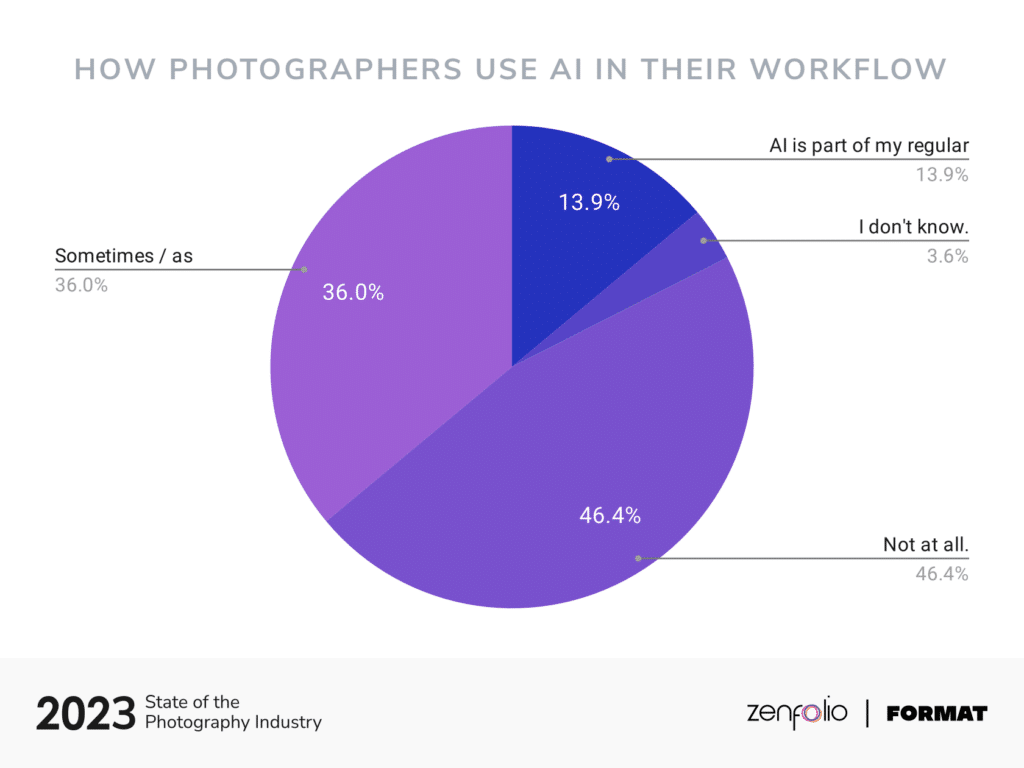
So among the photographers who use AI, what are they using it for?
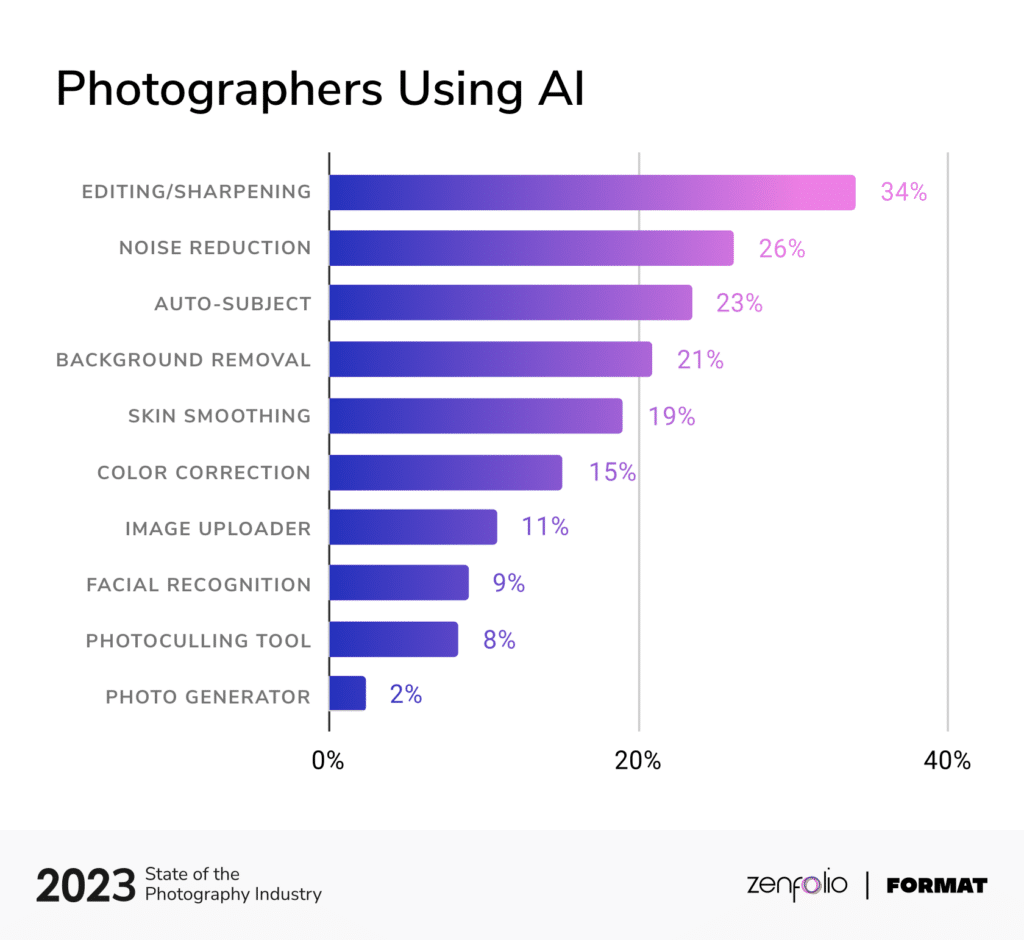
An obvious leading question is whether photographers are embracing AI at all…and which specialties utilize it most? It’s maybe surprising that Canine and Wildlife photographers, in this survey, are using AI the most, followed closely by Wedding, School, Lifestyle, and Conceptual/Abstract specialties.
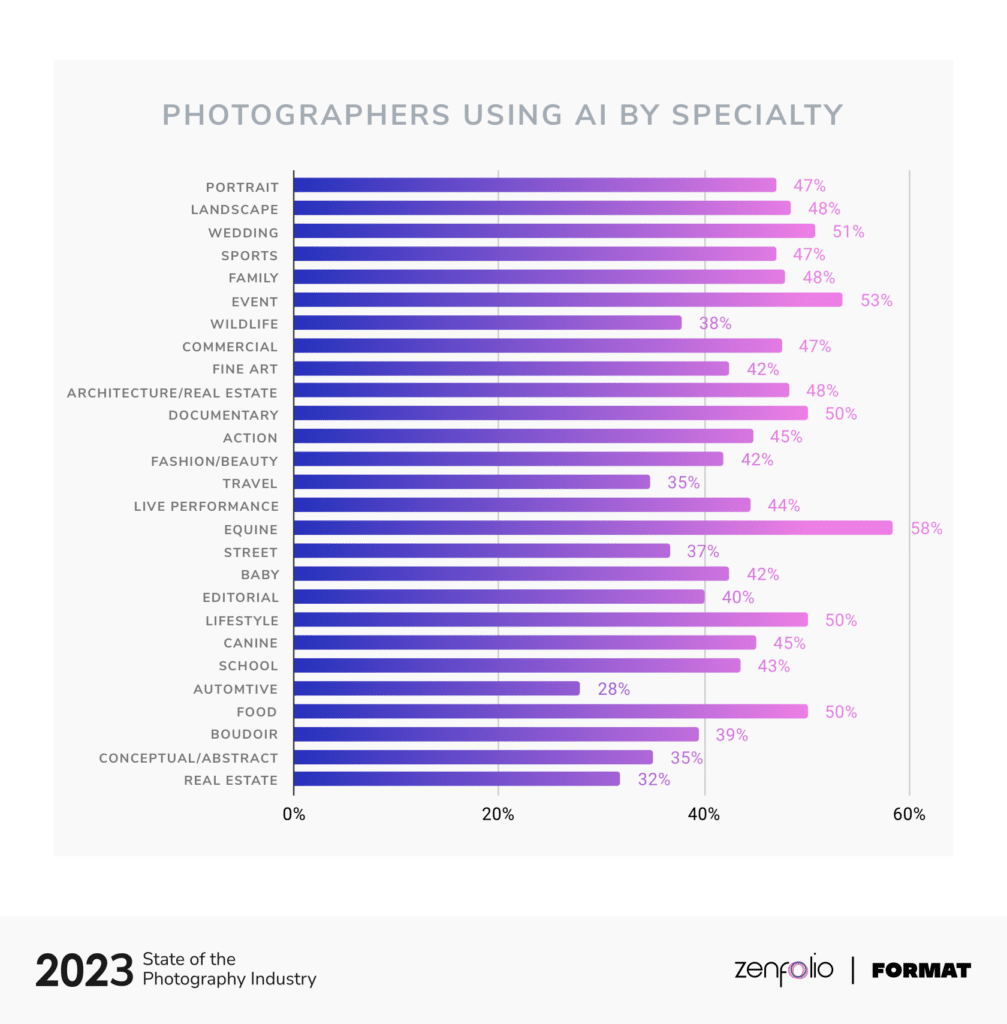
Until next time…
Before reviewing the results of this survey, you might have thought that the pandemic’s impact had vanished, or that photographers were immune to the rising inflation costs. However, the data shows us that there are still challenges to be faced. Despite this, the photography industry is full of resilient individuals who possess a unique blend of creative artistry, technical expertise, and adaptability to keep up with market trends. Although we face unprecedented economic fluctuations due to inflation, the photography sector is still growing and adapting.
By conducting this bi-annual survey and reporting the results, we hope that every photographer can see where they stand, continue to track what works and what doesn’t, evaluate the competitiveness of their pricing strategies, and deliver exceptional customer experiences.
Persistence. Perseverance. Perspiration. 2022 required it all. What will 2023 require to succeed?